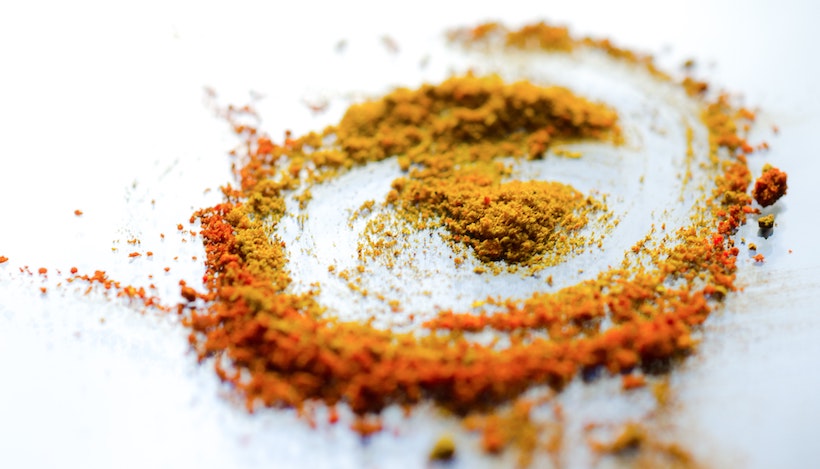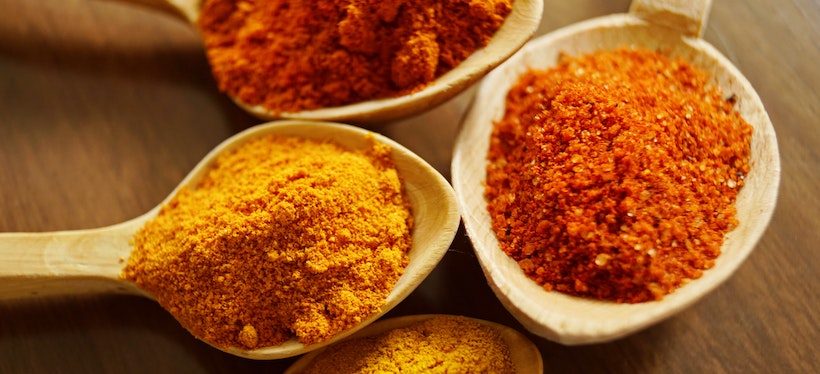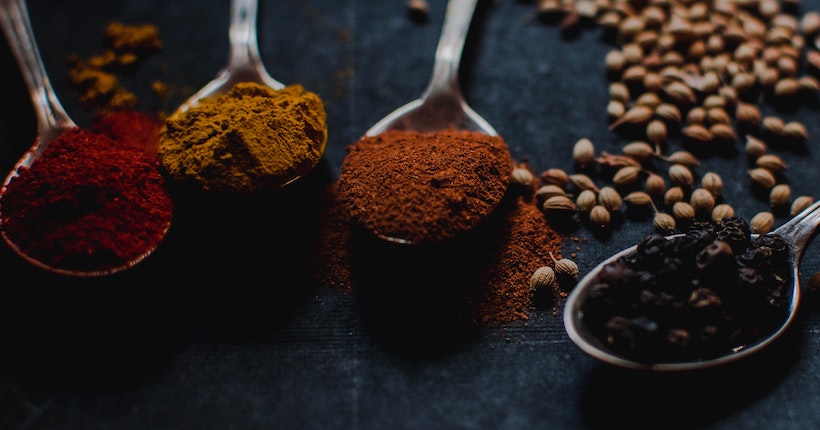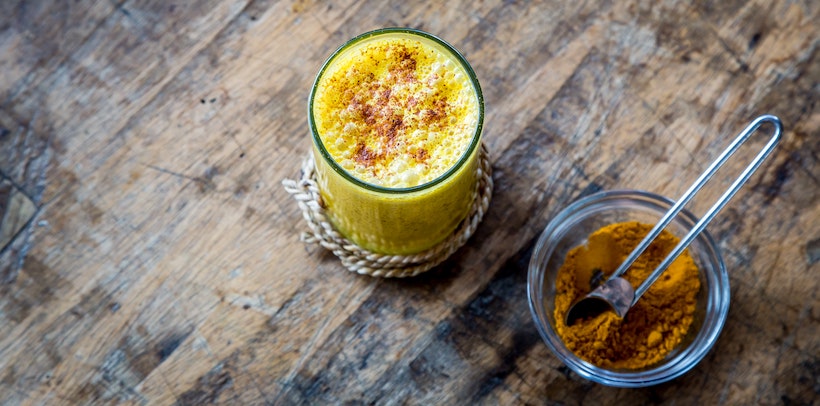Ever since I was a small child, I have been fascinated by turmeric. My grandmother and my mother used it a lot to prepare some of my favorite dishes, and I clearly remember being drawn to the bright color, the wonderful smell, and the unique taste of this fantastic spice.
To this day, I use turmeric as often as I can in my cooking. (Even in those dishes that don't necessarily call for it...)
This year, I decided to learn as much as possible about the stuff and its components. Today, let's talk about the health effects of turmeric and curcumin.
Turmeric is a perennial, rhizomatous, herbaceous plant that originated in the Indian subcontinent and Southeast Asia. It's in the same family as the ginger plant, and its roots are likewise used in cooking.
Because it requires a narrow band of temperature and constant rainfall to thrive, the plant was initially grown in certain regions with a specific climate. Today, however, its cultivation has spread to various areas of the world.
Turmeric has a pungent, earthy, and somewhat unique and slightly bitter taste. More often than not, it's used as a spice to add aroma and flavor to savory dishes. However, it's sometimes also used in sweet dishes and snacks, often combined with different products derived from the coconut fruit.
Typically, turmeric is used in South Asian and Middle Eastern cuisine. Its use is limited to those regions alone, though – it's is an integral part of various dishes in countries like South Africa, Cambodia, and others.
Turmeric is sometimes used in things other than cooking. Due to its vibrant golden yellow color, the spice is often used as a dye for both edible and non-edible objects, including some types of traditional clothing in countries like India. Unfortunately, the spice is not very lightfast, making it a relatively poor dye in the long run.
Due to its chemical properties, turmeric is often used as a food additive. When used in this particular way, the spice is coded as E100. Turmeric can also be used as a food coloring substance, providing a distinctly yellow tint that helps make foods like mustard, pickles, and relishes more visually attractive.
In some traditional social contexts, turmeric is used, to this day, as a medical supplement. This is particularly true for regions such as East India, where the plant's beneficial effects have been rumored for a long time.

Turmeric is composed of several substances, many of which are very noteworthy. The most important are:
Without a doubt, curcuminoids are the most important family of active components in turmeric. (And curcumin, the hero of this post, is the most well-known curcuminoid).
Among others, these polyphenolic pigments include curcumin, demethoxycurcumin, and bisdemethoxycurcumin.
The most important when it comes to human consumption, however, is curcumin. It's the most abundant curcuminoid in turmeric, and has a wide range of biological activities – many of them beneficial. Unfortunately, though, curcumin has a very poor absorption efficiency, making it difficult to administer orally as a supplement for treating different illnesses and ailments.
(One way to up its absorption is to take it with piperine, an active ingredient in pepper.)
While they are undoubtedly the most well-known, curcuminoids are not the only active components of turmeric.
Case and point, sesquiterpenes are powerhouses that abound in turmeric. These colorless components have a wide range of effects on the human body. They likely are anti-inflammatory, modulating inflammation and cytokine response. They have anti-tumor properties, are beneficial to cardiovascular conditions, and have a wide range of other beneficial properties – easing everything from migraines to pain.
Turmeric also has an abundance of other phytochemicals.
While these components haven't been shown to have a direct effect on human health, they have important effects on the preservation of plants themselves. While we haven't characterized every phytonutrient's role, they have roles in everything, from pigmentation to chemical messaging.
Plants produce phytochemicals to help them thrive in difficult environments. Additionally, they can help the plant thwart competitors, fight predators, and prevent attacks from different pathogens.
Like most foods, turmeric does count macronutrients in its composition – albeit in small quantities. These include proteins, carbohydrates, dietary fiber, fats, and calories.
However, due to its pungent, intense flavor and aroma, turmeric can't exactly be used in great quantities. That makes its contribution of macronutrients to your meal a bit of a rounding error.

Turmeric (and its main active component, curcumin) has been vastly and thoroughly examined concerning its health benefits and effects on the human body.
Here is some of the most exciting research on the effects of turmeric:
A long line of studies has shown that turmeric can be incredibly useful when dealing with arthritis. In particular, it's been shown to help patients with rheumatoid arthritis. In particular, curcumin has anti-inflammatory and antioxidant effects, which alleviate some of the worse effects of arthritis.
One of the most unexpected (and most welcome!) effects of turmeric on human health is its activity against conditions such as type II diabetes.
In various clinical trials, patients with dietary problems and risks of getting type II diabetes were treated with high concentrations of curcumin. Amazingly, these patients showed less propensity for developing type II diabetes than patients in control groups. Even better than that, patients in curcumin-treated groups were proven to have a better overall function of β-cells, which can help prevent the development of conditions such as type II diabetes.
Something else very noteworthy about turmeric and curcumin is they can help improve cholesterol in overweight patients.
Turmeric has a number of effects on metabolism that help improve lipid profiles – including total serum cholesterol, triglycerides, and LDL and VLDL cholesterol. As you can imagine, this can be of great help when treating patients who are in danger of developing life-threatening conditions due to obesity or metabolic syndrome.
Curcumin is very well-known due to its vast antioxidant and anti-inflammatory effects on the human body. In fact, the substance has been used traditionally as an anti-inflammatory for centuries in certain regions of the world.
Countless studies have shown that curcumin is a free radical scavenger. This is what we mean when we say curcumin has antioxidant properties.
At this point, I should clarify that not all the positive effects of turmeric and curcumin have been irrefutably proven in humans. Some of these supposed health benefits are still being investigated and researched.
One example of this? The apparent protective effect that curcumin has against liver damage.
Still in the investigation stage, this theory claims that the active component reduces the effect of carbon tetrachloride (CCl4) in the liver. This, in turn, results in added protection for the liver. At this point, however, scientists have only been able to test this hypothesis on rats – but keep an eye on developments here.

As I previously mentioned, curcumin has been proven to have definite antioxidant and anti-inflammatory effects on the human body. Some new research suggests that these effects can also help fight obesity and obesity-related diseases.
Primarily, scientists have found that obesity is often characterized by chronic low-grade inflammation and damaged metabolism. For those reasons, the anti-inflammatory action of phytochemicals like those in curcumin can reduce the adverse side effects of obesity on the human body.
Studies have shown a definite relationship between inflammation and the pathogenesis of atherosclerosis and cardiovascular disease (CVD).
As you already know, curcuminoids exhibit important cardio-protective and anti-inflammatory properties. Logic indicates that the use of turmeric-derived substances, including curcumin and other curcuminoids, can help reduce the risk posed by cardiovascular diseases.
One of the lesser-known side effects of obesity is unruly immuno-activation. This means that patients suffering from obesity will often have highly irregular immune reactions.
Luckily, curcumin has been shown to have immunomodulatory effects on the human body.
The over-production of plasma nitric oxide in the body may be implicated in the development of carcinogenesis and the progression of existing tumors. For that reason, it's crucial to have a balanced production of nitric oxide in the body.
Some studies have shown that curcumin can help the body regulate the production of nitric oxide.
A handful of studies have shown a possible link between the use of curcumin and the prevention (or reduction) of pathological processes related to cognitive decline, dementia, and various mood disorders.
The most recent study showed that a single dose of curcumin (400 mg) improved cognitive function, mood, and blood biomarkers in healthy adults aged 60 to 85.
Finally, we should talk about the positive effects of curcumin in post-workout muscle soreness.
Due to its already-discussed antioxidant and anti-inflammatory effects, curcumin is capable of reducing muscle soreness after intense workouts. These effects were significant and shown to be active for up to 72 hours after intake.

As with anything, the excessive or improper use of turmeric and curcumin might have negative effects on the human body.
Let's cover some of the most important potential adverse effects:
The Food and Drug Administration of the United States warns about contamination that stems from excessive intake of turmeric (curcumin).
Depending on its source, curcumin and turmeric are susceptible to high levels of lead. As you already know, excessive intake of lead can lead to a series of health issues, including lead poisoning, mood disorders, and lowered intelligence.
In moderate amounts, the consumption of turmeric should not cause digestive issues for people without pre-existing or aggravating conditions.
However, excessive intake of turmeric and its derivates may cause otherwise-healthy individuals to experience stomach ulcers, stomach ache, gas, nausea, and various other digestive problems.
Unfortunately, some studies have shown that a regular intake of curcumin can cause certain individuals to experience partial or complete atrioventricular blocks.
However, this is by no means a common occurrence. Without a doubt, more research and studies are required to understand this phenomenon more clearly.

With everything on the table, it is time to make a final assessment. Overall, is turmeric good for you? Clearly, the answer is yes.
Apart from providing great color, flavor, and aroma to your foods, this spice is packed full of active components that have been proven to have positive effects on your health. Curcumin, in particular, has been shown to provide significant benefits to the human body.
Okay, I'm excited about turmeric – but that's not to say everyone should take turmeric.
People with high blood pressure and diabetes will often take medications that are not compatible with curcuminoid intake. Individuals with a propensity for blood clots may also suffer adverse effects from the consumption of the spice. Finally, people with excessive stomach acid may see their condition worsen due to the intake of turmeric.
Even if you are not in any of the risk groups above mentioned, your intake of turmeric should be moderate and balanced – and you should talk through drug interactions with your pharmacist or doctor.
As a side note, too much turmeric might trigger problems for you as opposed to curcumin specifically. Taking curcumin extract may prove more effective (and biologically efficient) than eating turmeric regularly.
Turmeric is an interesting sprice, and a worthy addition to many a dish. It's also a beautiful spice – it looks as good in the spice drawer as it does in your meal.
As you've seen, it's also packed with amazing bio-active phytochemicals like curcumin, a substance with fantastic health benefits.
So – load up your dishes with turmeric. I'll be doing the same.
Great post!